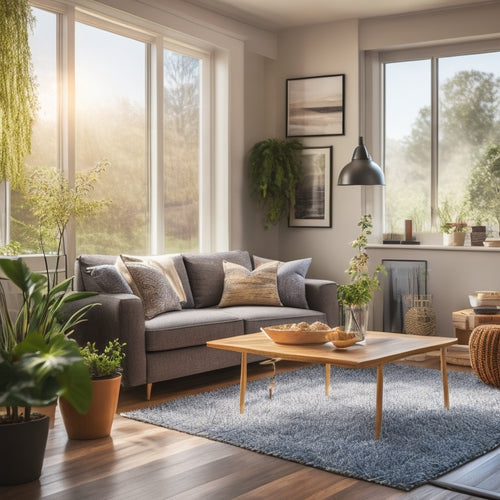
5 Best Solar Panel System Design Tools for Architects
Share
When designing solar panel systems, you need the right tools to optimize performance and streamline your workflow. You'll want to explore options like Helioscope, Aurora Solar Tools, Sketchup, and PVSYST Software. These tools offer advanced simulation capabilities, performance analysis, and cost optimization features to help you refine your designs. With intuitive interfaces and robust feature sets, you can create detailed 3D models, analyze shading and weather patterns, and identify areas with high solar potential. By leveraging these tools, you'll be able to reduce project timelines and costs while ensuring peak system performance. Now, discover how these tools can help you create efficient and effective solar panel system designs.
Key Takeaways
• Helioscope streamlines solar panel system design, reducing time and costs with advanced simulation capabilities and detailed project visualization.
• Aurora Solar Tools empowers architects to create and optimize solar panel system designs with accurate performance simulations and detailed project reports.
• Sketchup provides an intuitive interface for designing and visualizing solar panel systems, considering factors like roof orientation and shading.
• PVSYST Software offers advanced modeling capabilities to simulate and analyze PV system performance, optimizing design for maximum energy yield.
• These solar design software options provide user-friendly interfaces, performance simulation capabilities, and cost analysis features to help architects design efficient solar panel systems.
Top Solar Design Software Options
You can choose from a variety of solar design software options, ranging from free online tools to advanced CAD programs, to streamline your solar panel system design process. These software options provide a range of features to help you optimize your design.
A user-friendly interface is essential to efficiently design and analyze your solar panel system. Look for software that integrates with popular data sources, allowing seamless data integration and reducing errors. Performance simulation capabilities enable you to test and refine your design, ensuring maximum energy output.
Cost analysis features help you estimate project expenses and identify areas for cost reduction. Advanced software options also offer system optimization tools, which automatically suggest improvements to your design. By leveraging these features, you can create a highly efficient solar panel system that meets your clients' energy needs.
When selecting a solar design software, consider your specific needs and choose an option that aligns with your design process.
Streamlining Projects With Helioscope
By leveraging Helioscope's advanced design and simulation capabilities, architects can greatly streamline their solar panel system design projects, reducing design time and costs while improving overall system performance.
You'll be able to quickly and accurately design and simulate complex solar panel systems, ensuring peak energy output and return on investment.
One of the primary Helioscope benefits is its ability to provide detailed project visualization, allowing you to see exactly how your design will perform in real-world scenarios. This enables you to identify and address potential issues early on, reducing the risk of costly rework and revisions.
With Helioscope, you can easily test and optimize different system configurations, exploring various panel arrangements, inverter selections, and installation scenarios. This level of precision and flexibility enables you to deliver high-quality, enhanced solar panel systems that meet the unique needs of your clients.
Designing With Aurora Solar Tools
Aurora Solar Tools offers a thorough design platform that empowers architects to efficiently create and optimize solar panel system designs, ensuring accurate performance simulations and detailed project reports.
With Aurora's extensive suite of tools, you can streamline your solar workflows, reducing project timelines and costs. The platform's advanced algorithms and detailed shading analysis enable you to pinpoint ideal panel placement, maximizing energy output and reducing potential losses.
When designing with Aurora Solar Tools, you can leverage the platform's seamless integration with popular CAD software, allowing for effortless import and export of project data. This facilitates a smooth design-to-installation workflow, ensuring that your solar panel system designs are both efficient and effective.
By leveraging Aurora's advanced performance simulations and detailed reporting capabilities, you can confidently present your designs to clients, ensuring that their solar energy needs are met.
With Aurora Solar Tools, you can take your solar panel system designs to the next level, delivering high-performance solutions that meet the unique needs of your clients.
Efficient System Design With Sketchup
SketchUp's intuitive interface and robust feature set enable architects to efficiently design and visualize solar panel systems, streamlining the design-to-installation workflow. You can easily create detailed 3D models of buildings and integrate solar panels, taking into account factors like roof orientation, shading, and local building codes. This facilitates accurate assessments of solar potential and energy yield, ensuring well-informed system design.
With SketchUp, you can perform building simulation and analysis to identify areas with high solar potential. This information is essential for determining the best placement and configuration of solar panels. By leveraging SketchUp's solar integration capabilities, you can create detailed designs that balance energy production with aesthetic and functional considerations.
Moreover, SketchUp's collaboration tools enable seamless communication with stakeholders, ensuring that all parties are aligned on the design and installation process. By using SketchUp, you can streamline your workflow, reduce errors, and deliver high-quality solar panel system designs that meet your clients' requirements.
Advanced Modeling With PVSYST Software
You can achieve highly accurate solar panel system designs with PVSYST software, which offers advanced modeling capabilities to simulate and analyze the performance of photovoltaic systems under various environmental conditions.
This software enables you to create detailed models of your PV system, taking into account factors such as shading, terrain, and weather patterns. With PVSYST, you can optimize your PV system design for maximum energy yield and perform energy yield analysis to predict the system's performance over time.
The software's advanced modeling capabilities allow you to simulate the system's behavior under different scenarios, enabling you to identify potential bottlenecks and optimize the design for maximum efficiency. PVSYST's advanced modeling features also enable you to perform PV system optimization, ensuring that your design is optimized for maximum energy production.
Frequently Asked Questions
Can Solar Panels Be Installed on a Roof With Multiple Skylights?
When you're considering solar panels on a roof with multiple skylights, you'll need to assess skylight placement and potential roof obstructions, ensuring a clear path for sunlight and a structurally sound installation that meets local building codes.
Are There Any Solar Design Tools Compatible With Mac Computers?
"A million design possibilities await! You'll find numerous solar design tools compatible with Mac computers, offering seamless Mac compatibility and unparalleled design flexibility, such as Aurora Solar, Helioscope, and SketchUp, empowering you to create tailored solar panel systems with ease."
Do Solar Panels Work Efficiently in Shaded Areas or Partial Shade?
You'll experience reduced energy output due to shading losses, as even partial shade can decrease panel efficiency by up to 20%. Shaded areas have a substantial impact on performance, so it's important to assess shading patterns when designing solar panel systems.
Can I Use Solar Design Software Without Prior Solar Experience?
You can use solar design software without prior experience, as most platforms offer user guidance, software tutorials, and online training to make sure you meet industry standards and apply fundamental design principles.
Are There Any Free or Open-Source Solar Design Tools Available?
You're likely familiar with the phrase "many hands make light work." Similarly, open-source solar design tools harness collective expertise, offering cost-effective solutions. Yes, community-driven platforms like OpenStudio and SolarPath exist, prioritizing energy efficiency without the hefty price tag.
Related Posts
-

Solar Power for Community Energy Independence
Solar power is essential for your community's energy independence, offering both environmental and economic benefits....
-

Energy-Efficient Home Upgrades for Cost Reduction
To reduce costs with energy-efficient home upgrades, focus on essential improvements like smart thermostats, energy-e...
-

Solar Inverter Troubleshooting for Beginners
Troubleshooting your solar inverter starts with understanding its efficiency and performance metrics. Check for prope...


